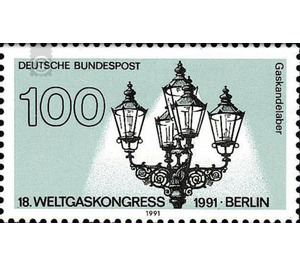18th World Gas Congress, Berlin 1991 - Germany / Federal Republic of Germany 1991 - 100 Pfennig
Theme: Devices, Items & Instruments
| Country | Germany / Federal Republic of Germany |
| Issue Date | 1991 |
| Face Value | 100.00 |
| Color | grey blue |
| Perforation | K 13:12 1/2 |
| Printing Type | Multicolor offset printing |
| Stamp Type | Postage stamp |
| Item Type | Stamp |
| Chronological Issue Number | 1411 |
| Chronological Chapter | GER-BRD |
| SID | 427424 |
| In 40 Wishlists | |
The first World Gas Congress took place in 1931 in London. Since then, the gas experts from all continents meet every three years to gather information about current research and development results and to exchange work experiences. The International Gas Union (IGU) is the World Association of Gas Associations of nearly 50 countries. The 18th World Gas Congress will be held from 8 to 11 July 1991 in the International Congress Center (ICC) Berlin. Organizer is the German association of the gas and water specialist e.V. Together with the congress traditionally the world gas exhibition takes place in the fair halls at the radio tower. The global interest in this event complex has grown steadily in recent decades. One reason for this is the growing importance of natural gas as an energy carrier and raw material. In Berlin, gas experts will focus on gas deployment and distribution strategies. Another important topic will be environmental protection. The German Federal Post Office honors the 18th World Gas Congress with the issue of a special postage stamp se-tenant with an intermediate field, which reminds with its motives of historical from the gas industry. This stamp shows one of the most beautiful five-armed gas candelabra in Berlin. It was made in no more known number of designs by Karl Friedrich Schinkel (1781-1841). Urban street lighting has existed in Berlin since 1682. It was preceded by a seldom-obeyed order from the Elector in 1676, according to which, in darkness, every third house had a burning lantern to hang. The first gas lantern of Berlin was ignited on 19 September 1826 under the linden trees. Just three years later, there were 1,800 lanterns. The necessary gasworks and supply systems were built by the British company Imperial Continental Gas Association and operated for many years. Berlin's own municipal gas works have been in existence since 1847. Even today, Berlin's streets and squares are illuminated by gas from about 200,000 incandescent bodies to more than 40,000.


